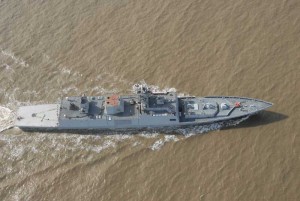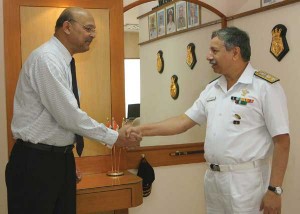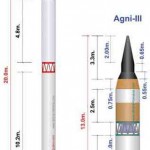Interview with Rear Admiral KN Vaidyanathan, Director General Naval Design
Shivalik, the first Ship of the P-17 Class, appears different from earlier designs of IN ships. What are the major new design features of this class of ships? Please elaborate on stealth features in particular and how were they achieved during design and construction and during acquisition of equipment from the industry?
Shivalik, the first of class of the P-17 frigates, heralds a paradigm shift in the design of future surface combatants for the Indian navy. While the sleek and stealthy appearance of Shivalik, sets her as a class apart from earlier indigenous designs, the ship embodies several new design features to give her much improved operational capabilities. “Stealth” has been a major thrust area from the early stages of the design. Apart from this, the design embodies several new concepts for improved survivability, seakeeping, ship handling and on-board habitability.
 The watertight subdivision of the hull meets the most stringent damaged stability requirements and the distributed power supply systems using Energy Distribution Centres (EDCs) has allowed zoning in the Power Generation & Distribution (PGD). The incorporation of the TACS (Total Atmosphere Control System) for the ship’s air conditioning and ventilation system, which features considerably reduced number of external air induction/exhaust terminals, gives her a very user friendly citadel which is easy to operate and maintain. This gives the additional benefit of uncluttered exteriors of the ship which has significantly reduced the Radar Cross section (RCS) of Shivalik.The hull form with carefully crafted hull sections and load water plane, gives the vessel excellent sea keeping qualities together with very good propulsion performance as a result of low shaft rake and very low appendages resistance. The relatively large rudders give the ship excellent manoeuvring performance as has been borne out by the ship trials. Use of modular accommodation has considerably improved on board habitability.
The watertight subdivision of the hull meets the most stringent damaged stability requirements and the distributed power supply systems using Energy Distribution Centres (EDCs) has allowed zoning in the Power Generation & Distribution (PGD). The incorporation of the TACS (Total Atmosphere Control System) for the ship’s air conditioning and ventilation system, which features considerably reduced number of external air induction/exhaust terminals, gives her a very user friendly citadel which is easy to operate and maintain. This gives the additional benefit of uncluttered exteriors of the ship which has significantly reduced the Radar Cross section (RCS) of Shivalik.The hull form with carefully crafted hull sections and load water plane, gives the vessel excellent sea keeping qualities together with very good propulsion performance as a result of low shaft rake and very low appendages resistance. The relatively large rudders give the ship excellent manoeuvring performance as has been borne out by the ship trials. Use of modular accommodation has considerably improved on board habitability.
The design of Shivalik evolved with considerable focus on reducing the ship signatures. Primary focus was on reducing the RCS, Infrared signatures and the Radiated underwater noise of the ship.
RCS: The hull form features flared main hull and sloped full beam superstructure to considerably reduce specular reflections. Special care was taken to avoid dihedral and trihedral corners which cause multiple radar scattering. The boat deck has been concealed behind radar suppression screens. The Gun turret in the foxle has a stealth canopy and the flush deck Vertical Launch Missile (VLMs) for the Surface to Surface Missiles (SSMs) have been conducive to reduced RCS.
P 17 is truly a watershed in the design history of the navy in terms of adopting new design concepts and new strategy for the design projects. This has set a definite course for managing and progressing the designs of P15 A destroyers, P 28 corvettes and P 71 Indigenous Aircraft carrier.
The helo hangar has sloped shutters and flush deck rails for helo traversing gear. The hull form and superstructure was evolved iteratively by extensive 3D CAD modelling and continuous RCS signature evaluation using specialist signature evaluation software.
IR Signature Reduction: The infrared signature reduction is achieved by using Eductor Diffuser IR suppression devices for the Gas turbine and the diesel engines. Besides exhaust gas cooling, hot metal cooling is achieved to afford good look-down protection from hostile IR sensors. The engine room ventilation with sea water coolers and acoustic enclosures for DAs help to reduce hull contrast temperatures.
Radiated noise: Acoustic studies were undertaken from early design stages by modelling the structure and airborne noise characteristics of machinery equipment to predict the underwater radiated noise. The results of these studies helped drive a balanced approach to noise reduction guiding the selection of machinery configuration and mounting arrangements with specifications for the structure borne vibrations and air borne noise which were included in the procurement orders of the equipment. Acoustic signatures were verified during factory acceptance trials, before clearing the noise critical machinery for installation onboard ship. The sea water suctions are arranged from carefully designed sea chests, to avoid radiation of fluid borne noises due to pump impulses.
Procuring machinery and equipment meeting the stringent vibration and airborne noise specifications was quite a challenge. However, I must say, the Indian industry has come some way to meet the requirements, but there is much road ahead to cover.
What are the major new systems in the Shivalik class? What are the new features in terms of the layouts on the ship?
Shivalik is the first IN ship to have a Combined Diesel or Gas Turbine (CODOG) propulsion plant. This propulsion configuration combines the compact high power/speed benefits of the gas turbines with the long endurance advantage of the diesel propulsion.
The twin shaft arrangement features relatively large, slow running propellers which, while driving the ship efficiently at the top speed, also have high cavitation inception speeds compared with earlier designs. This feature of the propeller compliments the low noise features of the machinery to provide silent speed regimes of operation up to cruise speeds. The Integrated Machinery Control System (IMCS) features multifunction displays with distributed Remote Terminal Units (RTUs) riding on a dual redundant Gigabit Ethernet data bus to monitor and control the ship’s propulsion and auxiliary systems including the Battle Damage Control System (BDCS).
The Automated Power Management System (APMS) manages the generation and distribution of electric power in the ship. The ship has an ATM based Integrated Ship Data Network (AISDN) which serves as the backbone on which the external and internal communication systems, data communication between weapons and indigenous sensors and navigation data distribution are supported.
The Integrated Versatile Console System (IVCS) replaces the earlier plug in systems providing multifunction display with touch screens for displaying all navigation data and status of weapons and sensors. The IVCS also supports the internal communication of the ship. The Combat management system, with fleet functionality, is a sophisticated development with considerable participation of the navy which will effectively co-ordinate the functions of the several weapons and sensors not only on board the ship but also those of other ships in company.
The P17 packs all the punch of a destroyer in her design.
The layout features wide alleyways and uncluttered upper decks. A centre line passage between the two helicopter hangars provides a clear lobby between the helo deck and the inside of the ship. The flush deck rails of the helo traversing system, besides being conducive to lower RCS, gives the ship much improved operational flexibility for the helicopter. The large bridge with generously provided bridge wings is ergonomically designed. The large windows of the bridge give very good all round visibility and the diverse equipment on the bridge are neatly packed into consoles for good aesthetics.





